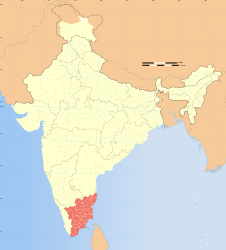List of chief ministers of Tamil Nadu
The Chief Minister of Tamil Nadu is the chief executive of the Indian state of Tamil Nadu. In accordance with the Constitution of India, the governor is a state's de jure head, but de facto executive authority rests with the chief minister. Following elections to the Tamil Nadu Legislative Assembly, the state's governor usually invites the party (or coalition) with a majority of seats to form the government. The governor appoints the chief minister, whose council of ministers are collectively responsible to the assembly. Given that he has the confidence of the assembly, the chief minister's term is for five years and is subject to no term limits.[1]
| Chief Minister of Tamil Nadu | |
|---|---|
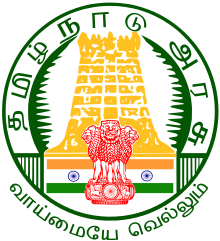 | |
| Chief Minister's Office | |
| Style | The Honourable (Formal) Mr. Chief Minister (Informal) |
| Status | Head of Government |
| Abbreviation | CM |
| Member of | |
| Reports to |
|
| Residence | No.9, P. S. Kumaraswamy Raja Road, Raja Annamalaipuram, Chennai, Tamil Nadu-600 028. |
| Seat | Chief Secretariat of Tamil Nadu, Chennai, Tamil Nadu |
| Appointer | Governor of Tamil Nadu by convention, based on appointee's ability to command confidence in the Tamil Nadu Legislative Assembly |
| Term length | At the pleasure of the governor Legislative Assembly term is 5 years unless dissolved sooner No term limits specified |
| Inaugural holder | A. Subbarayalu Reddiar |
| Formation | 17 December 1920 |
| Deputy | O. Panneerselvam |
| Salary | ₹2.05 lakh (US$2,900) (annual, including ₹12.6 lakh (US$18,000) MLA's salary) |
| Website | www |
The complete list of Chief Ministers of Tamil Nadu in the history of the state of Tamil Nadu in India since 1920. The area under the present-day state of Tamil Nadu has been part of different territorial configurations under Madras Presidency and Madras State in its history.[2][3]
The current incumbent is Edappadi K. Palaniswami of the All India Anna Dravida Munnetra Kazhagam since 16 February 2017.
Chief Ministers of Madras Presidency
The Madras Presidency, headquartered in Fort St. George, India, was a province of British India that comprised present day Tamil Nadu, the Malabar region of North Kerala, the coastal and Rayalaseema regions of Andhra Pradesh, and the Bellary, Dakshina Kannada, and Udupi districts of Karnataka. It was established in 1653 to be the headquarters of the English settlements on the Coromandel Coast.
The territory under the presidency comprised only Madraspatnam and surrounding regions. But, after the Anglo-French wars and the consequent alliance between the English East India Company and the Nawab of Arcot, it was expanded to comprise the region from Northern Circars to Cape Comorin. The governance structure also evolved from a modest secretariat with a single secretary for the Public Department in 1670 to six departments overseen by a chief secretary by 1920.
The Indian Councils Act 1861 set up the Madras Legislative Council as an advisory body, without powers, through which the colonial administration obtained advice and assistance from able and willing Indian business leaders. But membership was selected (not elected) and not representative of the masses.
With the enactment of Government of India Act 1919, the first legislature was formed in 1920 after general elections.[4] The term of the legislative council was three years. It had 132 members of whom 34 were nominated by the governor and the rest were elected. Under the Government of India Act 1935, a bicameral legislature was set up with a legislative assembly consisting of 215 members and a legislative council having 56 members. The first legislative assembly under this act was constituted in July 1937. The legislative council was a permanent body with a third of its members retiring every 3 years with power to decide on bills passed by the assembly[5]
In 1939, the British government declared India's entrance into World War II without consulting provincial governments. The Indian National Congress protested by asking all its elected representatives to resign from the governments.[6] Congress came back to power in 1946 after new provincial elections.[7]
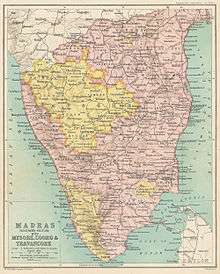

Chief Secretariat of Tamil Nadu
| S.No | Portrait | Name (birth–death) |
Political Party[lower-alpha 1] | Elected Constituency | Term of office[9] | Appointed by | Legislative Council Election | |||
|---|---|---|---|---|---|---|---|---|---|---|
| 1 |  |
A. Subbarayalu Reddiar (1855–1921) |
South Indian Liberal Federation | Leader of Madras Presidency Legislative Council | 17 December 1920 | 11 July 1921[RES] | 1st (206 days) |
Frederic Thesiger | 1st | |
| 2 | 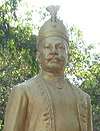 |
Panaganti Ramarayaningar (1866–1928) |
South Indian Liberal Federation | Leader of Madras Presidency Legislative Council | 11 July 1921 | 11 September 1923 | 1st (792 days) |
Rufus Isaacs | ||
| South Indian Liberal Federation | Head of Madras Presidency Legislative Council | 19 November 1923 | 3 December 1926 | 2nd (1,111 days) |
2nd | |||||
| 3 |  |
P. Subbarayan (1889–1962) |
Unaffiliated | Leader of Madras Presidency Legislative Council | 4 December 1926 | 27 October 1930 | 1st (1,423 days) |
Edward Wood | 3rd | |
| 4 |  |
B. Munuswamy Naidu (1885–1935) |
South Indian Liberal Federation | Leader of Madras Presidency Legislative Council | 27 October 1930 | 4 November 1932[RES] | 1st (740 days) |
Edward Wood | 4th | |
| 5 | Ramakrishna Ranga Rao (1901–1978) |
South Indian Liberal Federation | Leader of Madras Presidency Legislative Council | 5 November 1932 | 5 November 1934 | 1st (730 days) |
Freeman Freeman-Thomas | |||
| South Indian Liberal Federation | Leader of Madras Presidency Legislative Council | 5 November 1934 | 4 April 1936[RES] | 2nd (516 days) |
5th | |||||
| 6 |  |
P. T. Rajan (1892–1974) |
South Indian Liberal Federation | Leader of Madras Presidency Legislative Council | 4 April 1936 | 24 August 1936[RES] | 1st (142 days) | |||
| (5) | Ramakrishna Ranga Rao (1901–1978) |
South Indian Liberal Federation | Leader of Madras Presidency Legislative Council | 24 August 1936 | 1 April 1937 | 3rd (220 days) |
Victor Hope | |||
| 7 | Kurma Venkata Reddy Naidu (1875–1942) |
Unaffiliated[10][11][12][13] | Leader of Madras Presidency Legislative Council | 1 April 1937 | 14 July 1937[RES] | 1st (104 days) |
1st | |||
| 8 |  |
C. Rajagopalachari (1878–1972) |
Indian National Congress | Leader of Madras Presidency Legislative Council | 14 July 1937 | 29 October 1939[RES] | 1st (837 days) | |||
| - |  |
Governor's Rule[14] | N/A | 29 October 1939 | 30 April 1946 | (2,375 days) | ||||
| 9 | 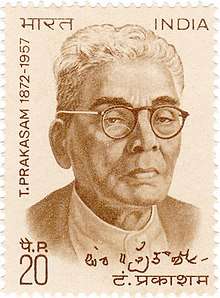 |
T. Prakasam (1872–1957) |
Indian National Congress | Leader of Madras Presidency Legislative Council | 30 April 1946 | 23 March 1947[RES] | 1st (327 days) |
Archibald Wavell | 2nd | |
| 10 | 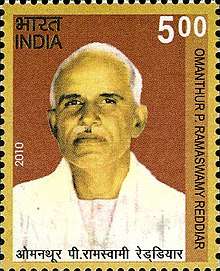 |
Omanthur P. Ramaswamy Reddiar (1895–1970) |
Indian National Congress | Leader of Madras Presidency Legislative Council | 23 March 1947 | 6 April 1949[RES] | 1st (745 days) |
Archibald Nye | ||
| 11 | 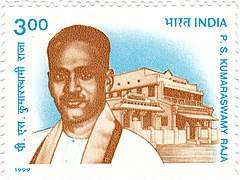 |
P. S. Kumaraswamy Raja (1898–1957) |
Indian National Congress | Leader of Madras Presidency Legislative Council | 6 April 1949 | 26 January 1950 | 1st (295 days) |
Krishna Kumarsinhji Bhavsinhji | ||
- Key
Timeline

Chief Ministers of Madras State
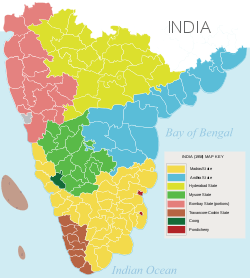
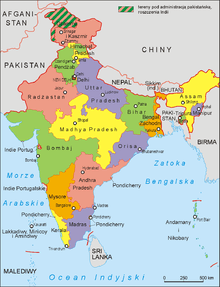
Madras State, precursor to the present day state of Tamil Nadu, was created after India became a republic on 26 January 1950.[15] It comprised present-day Tamil Nadu and parts of present-day Andhra Pradesh, Karnataka and Kerala. The first legislature of the Madras State to be elected on the basis of universal suffrage was constituted on 1 March 1952, after the general elections held in January 1952.[16]
The state was split up along linguistic lines in 1953, carving out Andhra State. Under the States Reorganisation Act, 1956, the States of Kerala, and Mysore were carved out of Madras state. Under the implementation of the Andhra Pradesh and Madras Alteration of Boundaries Act, 1959, with effect from 1 April 1960, Tirutani taluk and Pallipattu sub-taluk of Chittoor district of Andhra Pradesh were transferred to Madras in exchange for territories from the Chingelput and Salem districts.[4][17]
- Colour key for party of the chief ministers
- Other key
| S.No | Portrait | Name (birth–death) |
Political Party[lower-alpha 1] | Elected Constituency | Term of office[9] | Appointed by | Legislative Assembly Election | |||
|---|---|---|---|---|---|---|---|---|---|---|
| 1 |  |
P. S. Kumaraswamy Raja (1898–1957) |
Indian National Congress | Leader of Madras State Legislative Council | 27 January 1950 | 9 April 1952 | 1st (805 days) |
Krishna Kumarsinhji Bhavsinhji | 2nd | |
| 2 |  |
C. Rajagopalachari (1878–1972) |
Indian National Congress | Leader of Madras State Legislative Council | 10 April 1952 | 13 April 1954[RES] | 2nd (733 days) |
Sri Prakasa | 1st | |
| 3 |  |
K. Kamaraj (1903–1975) |
Indian National Congress | Gudiyatham, Veeloor | 13 April 1954 | 31 March 1957 | 1st (1,083 days) |
Sri Prakasa | ||
| Sattur, Virudhunagar | 13 April 1957 | 1 March 1962 | 2nd (1,783 days) |
A. J. John | 2nd | |||||
| 15 March 1962 | 2 October 1963[RES] | 3rd (566 days) |
Bishnuram Medhi | 3rd | ||||||
| 4 | 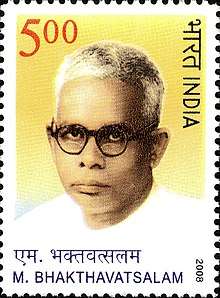 |
M. Bhakthavatsalam (1897–1987) |
Indian National Congress | Thiruperumputhoor, Kancheepuram | 2 October 1963 | 28 February 1967 | 1st (1245 days) |
Bishnuram Medhi | ||
| 5 |  |
C. N. Annadurai (1909–1969) |
Dravida Munnetra Kazhagam | Leader of Madras State Legislative Council | 6 March 1967 | 13 January 1969 | 1st (680 days) |
Sardar Ujjal Singh | 4th | |
Timeline

Chief Ministers of Tamil Nadu

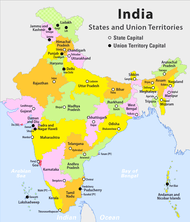
Madras State was renamed as Tamil Nadu (Tamil for Tamil Country) on 14 January 1969.[15] The legislative assembly adopted a resolution on 14 May 1986, to abolish the legislative council. Thereafter, the legislative council was abolished through an act of Parliament named the Tamil Nadu Legislative Council (Abolition) Act, 1986[18] with effect from 1 November 1986. The state legislature is unicameral, and consists of 235 members including one nominated member.[5]
The chief minister commands most of the executive powers while the governor has a largely ceremonial role. The chief minister of Tamil Nadu, like other chief ministers of India, is elected by legislators of the political party or the coalition which commands a simple majority in the legislative assembly. The tenure of the chief minister extends as long as he or she enjoys the confidence of the assembly. The incumbent shall vacate the office in the event of a successful motion of no confidence. Also, the President of India, acting under the recommendations of the cabinet of ministers of the Government of India, can dismiss an elected government using certain provisions of Article 356 of the Constitution of India. In 1976, M. Karunanidhi's government was dismissed and president's rule was imposed on the grounds of corruption.[19] If a vacancy is caused to the office of the chief minister due to death, demitting, or dismissal, the governor can invite another person to form the government and request him or her to move a confidence-seeking motion in the assembly. In the event of no one enjoying majority support, the assembly is either dissolved or put in suspended animation and the state comes under president's rule or a caretaker government until fresh elections are held for the assembly. The incumbent shall be disqualified if convicted of a criminal offence with a jail sentence of two years or more. In 2014, J. Jayalalithaa lost her post due to a special court sentencing her to four years of prison term in the disproportionate assets case.[20]
|
|
| S.No | Portrait | Name (birth–death) |
Political Party[lower-alpha 1] | Elected Constituency | Term of office[9] | Appointed by | Legislative Assembly Election | |||
|---|---|---|---|---|---|---|---|---|---|---|
| 1 |  |
C. N. Annadurai (1909–1969) |
Dravida Munnetra Kazhagam | Leader of Tamil Nadu Legislative Council | 14 January 1969 | 3 February 1969[†][21] | 1st (20 days) |
Sardar Ujjal Singh | 4th | |
| - | 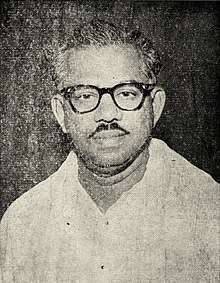 |
V. R. Nedunchezhiyan (1920–2000) |
Dravida Munnetra Kazhagam | Thiruvallikkeni, Chennai | 4 February 1969 | 9 February 1969 | 1st (5 days) | |||
| 2 |  |
M. Karunanidhi (1924–2018) |
Dravida Munnetra Kazhagam | Saithaappettai, Chennai | 10 February 1969 | 5 January 1971 | 1st (694 days) | |||
| * |  |
President's rule[15] | N/A | N/A | 6 January 1971 | 14 March 1971 | 1st (68 days) |
Varahagiri Venkata Giri | ||
| (2) |  |
M. Karunanidhi (1924–2018) |
Dravida Munnetra Kazhagam | Saithaappettai, Chennai | 15 March 1971 | 31 January 1976 | 2nd (1783 days) |
Sardar Ujjal Singh | 5th | |
| * |  |
President's rule[15] | N/A | N/A | 1 February 1976 | 29 June 1977 | 2nd (514 days) |
Fakhruddin Ali Ahmed | ||
| 3 | 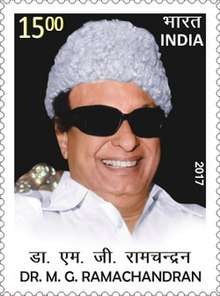 |
M. G. Ramachandran (1917–1987) |
All India Anna Dravida Munnetra Kazhagam | Aruppukottai, Virudhunagar | 30 June 1977 | 17 February 1980 | 1st (962 days) |
Prabhudas Patwari | 6th | |
| * |  |
President's rule[15] | N/A | N/A | 18 February 1980 | 8 June 1980 | 3rd (111 days) |
Neelam Sanjiva Reddy | ||
| (3) |  |
M. G. Ramachandran (1917–1987) |
All India Anna Dravida Munnetra Kazhagam | Mathurai Merku, Mathurai | 9 June 1980 | 15 November 1984 | 2nd (1620 days) |
Prabhudas Patwari | 7th | |
| - |  |
V. R. Nedunchezhiyan (1920–2000) |
All India Anna Dravida Munnetra Kazhagam | Aathoor, Thindukkal | 16 November 1984 | 9 February 1985 | 2nd (85 days) |
Sundar Lal Khurana | 8th | |
| (3) |  |
M. G. Ramachandran (1917–1987) |
All India Anna Dravida Munnetra Kazhagam | Aandippatti, Theni | 10 February 1985 | 24 December 1987[†] | 3rd (1047 days) | |||
| - |  |
V. R. Nedunchezhiyan (1920–2000) |
All India Anna Dravida Munnetra Kazhagam | Aathoor, Thindukkal | 25 December 1987 | 6 January 1988 | 3rd (12 days) | |||
| 4 | 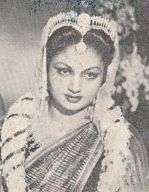 |
V. N. Janaki Ramachandran (1923–1996) |
All India Anna Dravida Munnetra Kazhagam | Not Contested | 7 January 1988 | 30 January 1988 | 1st (23 days) | |||
| * |  |
President's rule[15] | N/A | N/A | 31 January 1988 | 26 January 1989 | 4th (361 days) |
Ramaswamy Venkataraman | ||
| (2) |  |
M. Karunanidhi (1924–2018) |
Dravida Munnetra Kazhagam | Harbour, Chennai | 27 January 1989 | 30 January 1991 | 3rd (733 days) |
P. C. Alexander | 9th | |
| * |  |
President's rule[15] | N/A | N/A | 31 January 1991 | 23 June 1991 | 5th (143 days) |
Ramaswamy Venkataraman | ||
| 5 | 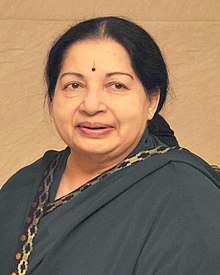 |
J. Jayalalithaa (1948–2016) |
All India Anna Dravida Munnetra Kazhagam | Bargur, Krishnagiri and Kaangayam, Tiruppur | 24 June 1991 | 12 May 1996 | 1st (1784 days) |
Bhishma Narain Singh | 10th | |
| (2) |  |
M. Karunanidhi (1924–2018) |
Dravida Munnetra Kazhagam | Chepaukkam, Chennai | 13 May 1996 | 13 May 2001 | 4th (1826 days) |
Marri Chenna Reddy | 11th | |
| (5) |  |
J. Jayalalithaa (1948–2016) |
All India Anna Dravida Munnetra Kazhagam | Did not contest, all 4 nominations rejected due to TANSI case | 14 May 2001 | 21 September 2001 | 2nd (130 days)[22] |
Fathima Beevi | 12th | |
| 6 | 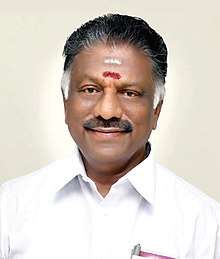 |
O. Panneerselvam (1951–) |
All India Anna Dravida Munnetra Kazhagam | Periyakulam, Theni | 22 September 2001 | 1 March 2002[RES] | 1st (160 days) |
C. Rangarajan | ||
| (5) |  |
J. Jayalalithaa (1948–2016) |
All India Anna Dravida Munnetra Kazhagam | Aandippatti, Theni | 2 March 2002 | 12 May 2006 | 3rd (1532 days)[22] |
P. S. Ramamohan Rao | ||
| (2) |  |
M. Karunanidhi (1924–2018) |
Dravida Munnetra Kazhagam | Chepaukkam, Chennai | 13 May 2006 | 15 May 2011[23] | 5th[24] (1828 days) |
Surjit Singh Barnala | 13th | |
| (5) |  |
J. Jayalalithaa (1948–2016) |
All India Anna Dravida Munnetra Kazhagam | Thiruvarangam, Thiruchirappalli | 16 May 2011 | 27 September 2014[20] | 4th[25] (1230 days) |
14th | ||
| * | Vacant | N/A | 28 September 2014 | 1 day | ||||||
| (6) |  |
O. Panneerselvam (1951–) |
All India Anna Dravida Munnetra Kazhagam | Bodinayakkanur, Theni | 29 September 2014[26] | 22 May 2015[RES][27] | 2nd (235 days) |
Konijeti Rosaiah | ||
| (5) |  |
J. Jayalalithaa (1948–2016) |
All India Anna Dravida Munnetra Kazhagam | Dr. Radhakrishnan Nagar, Chennai | 23 May 2015[28] | 22 May 2016 | 5th (366 days) | |||
| 23 May 2016[29] | 5 December 2016[†] | 6th (196 days) |
15th | |||||||
| (6) |  |
O. Panneerselvam (1951–) |
All India Anna Dravida Munnetra Kazhagam | Bodinayakkanur, Theni | 6 December 2016[30] | 15 February 2017[RES][31] | 3rd (71 days) |
C. Vidyasagar Rao | ||
| 7 | 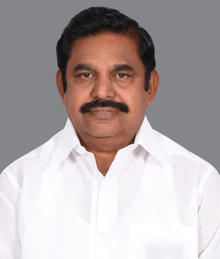 |
Edappadi K. Palaniswami (1954–) |
All India Anna Dravida Munnetra Kazhagam | Edappadi, Salem | 16 February 2017[32] | Incumbent | 1st (1226 days) | |||
Timeline
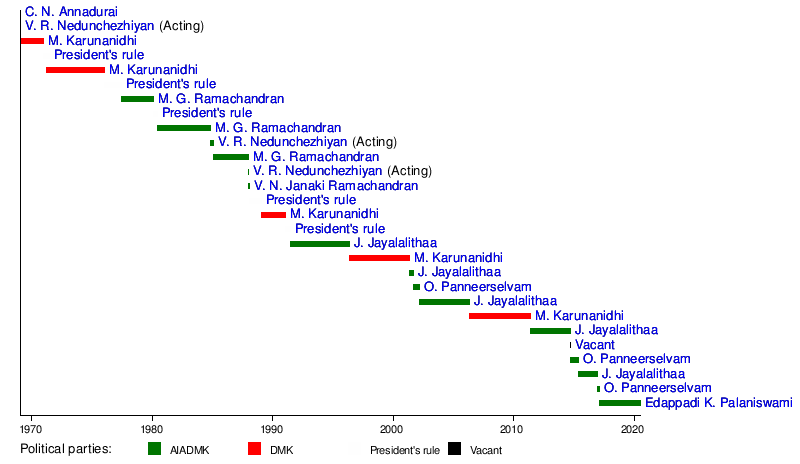
List of Chief Ministers by length of tenure
| No. | Name | Party | Length of term | |
|---|---|---|---|---|
| Longest continuous term | Total days of premiership | |||
| 1 | M. G. Ramachandran | AIADMK | 3629 days | 3629 days |
| 2 | K. Kamaraj | INC | 3432 days | 3432 days |
| 3 | M. Karunanidhi | DMK | 1828 days | 6863 days |
| 4 | J. Jayalalithaa | AIADMK | 1784 days | 5238 days |
| 5 | M. Bhakthavatsalam | INC | 1245 days | 1245 days |
| 6 | Edappadi K. Palaniswami | AIADMK | 1226 days | 1226 days |
| 7 | P. S. Kumaraswamy Raja | INC | 805 days | 805 days |
| 8 | C. Rajagopalachari | INC | 733 days | 733 days |
| 9 | C. N. Annadurai | DMK | 700 days | 700 days |
| 10 | O. Panneerselvam | AIADMK | 235 days | 466 days |
| 11 | V. N. Janaki Ramachandran | AIADMK | 23 days | 23 days |
List of Chief Ministers by party
Following is the summary of hold of Chief Minister's office by members of Indian political parties. The data to some extent may not reflect latest accurate set of informations as the length of term for ruling party will continue to change everyday and may be updated periodically only. The displayed data is as of 26 June 2020.
| No. | Political party | Number of Chief Ministers | Total days of holding CM Office |
|---|---|---|---|
| 1 | All India Anna Dravida Munnetra Kazhagam | 5 | 10679 days |
| 2 | Indian National Congress | 6 | 8425 days |
| 3 | Dravida Munnetra Kazhagam | 2 | 7568 days |
| 4 | South Indian Liberal Federation | 5 | 4497 days |
| 5 | Unaffiliated | 2 | 1527 days |
Parties by number of their members served as Tamil Nadu Chief Ministers
Living former Chief Ministers
As of 26 June 2020, there is only one living former Chief minister of Tamil Nadu
| Name | Portrait | Term of office | Date of birth |
|---|---|---|---|
| O. Panneerselvam |  |
22 September 2001 – 1 March 2002, 29 September 2014 – 22 May 2015, 6 December 2016 – 15 February 2017 (466 days) |
14 January 1951 |
The most recent death of a former Chief Minister was that of M. Karunanidhi on 7 August 2018, aged 94.
Records
- M. G. Ramachandran was the chief minister with the longest tenure ignoring an intervening president's rule from 17 February 1980 to 9 June 1980. His terms lasted for 10 years, 5 months and 25 days from 30 June 1977 until his death on 24 December 1987.
- K. Kamaraj was the chief minister with the longest tenure without intervening president's rule. His terms lasted from 13 April 1954 to 2 October 1963, i.e., 9 years, 5 months and 19 days.
- C. Rajagopalachari became the first chief minister in India to receive the highest civilian award Bharat Ratna.
- C. Rajagopalachari was the oldest chief minister of Tamil Nadu.
- C. Rajagopalachari (1954), K. Kamaraj (1976) and M. G. Ramachandran (1988) are the chief ministers from the state of Tamil Nadu to receive Bharat Ratna, the highest civilian award of the Republic of India.
- C. N. Annadurai became the first chief minister of Tamil Nadu to die in office on 3 February 1969.
- M. G. Ramachandran became the first actor-turned chief minister in India.
- V. N. Janaki Ramachandran became the first woman chief minister of Tamil Nadu.
- V. N. Janaki Ramachandran became the first actress-turned chief minister in India.
- The shortest period is by V. N. Janaki Ramachandran who held office only for 23 days.
- J. Jayalalithaa became the first woman leader of opposition in Tamil Nadu Legislative Assembly.
- J. Jayalalithaa became the first woman chief minister of Tamil Nadu by winning legislative assembly election in 1991.
- J. Jayalalithaa was the youngest chief minister of Tamil Nadu.
- J. Jayalalithaa became the first actress-turned chief minister in India by winning legislative assembly election.
- J. Jayalalithaa holds a record by being sworn as chief minister six times, followed by Karunanidhi who sworn five times.
- J. Jayalalithaa and M. Karunanidhi were the chief ministers from the state of Tamil Nadu protected with Z+ Security.
- On 21 September 2001, the Supreme Court of India ruled that the appointment of J. Jayalalithaa as chief minister on 14 May 2001 was invalid, with retrospective effect. Therefore, technically, decisions of her cabinet during the period May–September 2001 in effect became legal fiction.
- J. Jayalalithaa became the first incumbent chief minister to lose her post in a graft case when a special court sentenced her to four years of prison term on 27 September 2014.[20] The sentence was subsequently overturned by the Karnataka High Court which acquitted J. Jayalalithaa of all charges and that allowed her to return to the post for a fourth term.
- M. Karunanidhi had been in the office as chief minister for 6,863 days (around 18 years) in multiple tenures. Also was the only chief minister holding posts at different occasions spanning six decades starting from 1960s (from 1969), 1970s (until 1976), 1980s (from 1989), 1990s (until 1991 and again from 1996), 2000s (until 2001 and again from 2006) and 2010s (up to 2011).
- J. Jayalalithaa became the first woman chief minister of Tamil Nadu to win the legislative assembly election consecutively 2 times.
- J. Jayalalithaa became the first woman chief minister in India to die in office on 5 December 2016. She was the seventeenth chief minister to die in office in India and the third in Tamil Nadu, after C. N. Annadurai and M. G. Ramachandran.
- J. Jayalalithaa became the longest served woman chief minister of Tamil Nadu in multiple tenures.
- K. Kamaraj was the first and only chief minister in Tamil Nadu to get honored posthumously by changing the name of suburban railway station after him that is Maraimalai Nagar railway station renamed as Maraimalai Nagar Kamarajar Railway Station.
- M. G. Ramachandran was the first and only chief minister in Tamil Nadu to get honored posthumously by changing the name of iconic railway station after him that is Chennai Central railway station renamed as Puratchi Thalaivar Dr. M.G. Ramachandran Central Railway Station.
- C. Rajagopalachari was the only former chief minister of Tamil Nadu to have his portrait installed posthumously in the central hall of the Parliament of India
- K. Kamaraj, C. N. Annadurai and M. G. Ramachandran were the former chief ministers of Tamil Nadu to have their life-size statue unveiled posthumously in the Parliament of India.
- C. Rajagopalachari, K. Kamaraj, C. N. Annadurai, M. G. Ramachandran and J. Jayalalithaa were the former chief ministers of Tamil Nadu to have their portraits installed posthumously in Tamil Nadu Legislative Assembly.
- C. N. Annadurai (1968), M. Karunanidhi (1971), M. G. Ramachandran (1974), J. Jayalalithaa (1991) and Edappadi K. Palaniswami (2019) were the chief ministers of Tamil Nadu received Honorary Doctorate from various universities of Tamil Nadu.
See also
| Wikimedia Commons has media related to Chief ministers of Tamil Nadu. |
- Elections in Tamil Nadu
- History of Tamil Nadu
- List of current Indian chief ministers
- List of Governors of Tamil Nadu
- List of Speakers of the Tamil Nadu Legislative Assembly
Notes
- This column only names the chief minister's party. The state government he heads may be a complex coalition of several parties and independents; these are not listed here.
References
- Durga Das Basu. Introduction to the Constitution of India. 1960. 20th Edition, 2011 Reprint. pp. 241, 245. LexisNexis Butterworths Wadhwa Nagpur. ISBN 978-81-8038-559-9. Note: although the text talks about Indian state governments in general, it applies for the specific case of Tamil Nadu as well.
- Archive.org — Government of Tamil Nadu — Chief Ministers of Tamil Nadu since 1920
- Government of Tamil Nadu — Assemblies — An Overview Archived 6 October 2014 at the Wayback Machine
- Government of Tamil Nadu — Tamil Nadu Secretariat — Brief History
- "Legislative bodies of India - Tamil Nadu Legislative Assembly". Archived from the original on 2 January 2010. Retrieved 11 June 2006.
- The Telegraph - Own Goal - Partition became inevitable once the Congress resigned in 1939
- Pakistan - toward partition
- Mariappan, Julie (31 May 2013). "Tamil Nadu population rises to 7.2 crore in a decade". The Times of India. Retrieved 27 September 2015.
- The ordinal number of the term being served by the person specified in the row in the corresponding period
- Though Congress won the election, it refused to form the government as it did not like the governor's veto power over the cabinet. The governor of Madras, Lord Erskine, decided to form an interim provisional Government with non-members and opposition members of the Legislative Assembly. V. S. Srinivasa Sastri was first offered the chief ministership of the interim government but refused to accept it. Eventually an interim government was formed under Kurma Venkata Reddy Naidu on 1 April 1937. It lasted until July, when the Congress accepted Viceroy Linlithgow's assurance that the veto would not be abused and decided to form the government.
- Ramanathan, K. V. (2008). The Satyamurti letters: the Indian freedom struggle through the eyes of a parliamentarian, Volume 1. Pearson Education India. pp. 301–5. ISBN 9788131714881.
- Menon, Visalakshi (2003). From movement to government: the Congress in the United Provinces, 1937-42. Sage. p. 75. ISBN 9780761996200.
- Nagarajan, Krishnaswami (1989). Dr. Rajah Sir Muthiah Chettiar: a biography. Annamalai University. pp. 63–70.
- Congress Ministries in all the provinces of British India resigned on 29 October 1939 protesting the viceroy's declaration of war against Germany. Madras Presidency remained under "the direct rule of the Governor of the Province" until the next elections were held in March 1946. (India (Failure of Constitutional Machinery) HC Deb 16 April 1946 vol 421 cc2586-92)
- World Statesmen.org — Indian states since 1947
- Government of Tamil Nadu — The State Legislature — Origin and Evolution Archived 13 April 2010 at the Wayback Machine
- Historical Importance of Kanchipuram Archived 18 May 2006 at the Wayback Machine
- "The Tamil Nadu Legislative Council (Abolition) Act, 1986".
- "The Hindu - Delhi's warning". Archived from the original on 20 June 2006. Retrieved 11 June 2006.
- "Jayalalitha is the first CM to lose post in a graft case". DNA India. 27 September 2014.
- "DMK, AIADMK pay homage to Annadurai". Archived from the original on 4 March 2005.
... the leader's life was cut short by cancer 3 February 1969.
- On 21 September 2001, a five-judge constitutional bench of the Supreme Court of India ruled in a unanimous verdict that "a person who is convicted for a criminal offence and sentenced to imprisonment for a period of not less than two years cannot be appointed the Chief Minister of a State under Article 164 (1) read with (4) and cannot continue to function as such". Thereby, the bench decided that "in the appointment of Ms. Jayalalithaa as chief minister there has been a clear infringement of a constitutional provision and that a writ of quo warranto must issue". In effect her appointment as chief minister was declared null and invalid with retrospective effect. Therefore, technically, she was not the chief minister in the period between 14 May 2001 and 21 September 2001 (The Hindu — SC unseats Jayalalithaa as CM Archived 28 November 2004 at the Wayback Machine, Full text of the judgment from official Supreme Court site Archived 27 June 2006 at the Wayback Machine).
- "The Hindu - Karunanidhi resigns". Archived from the original on 16 May 2011. Retrieved 16 May 2011.
- BBC News - New leader for Tamil Nadu state
- "Jayalalithaa begins third term as Chief Minister today". NDTV. 16 May 2011.
- Jayalalithaa's trusted aide Panneerselvam sworn as Tamil Nadu's new chief minister
- O Panneerselvam resigns from Chief Minister post
- "Jayalalitha sworn in as chief minister of Tamil Nadu". BBC News. 23 May 2015. Retrieved 10 July 2015.
- PTI. "AIADMK comes to power again; Jayalalitha bucks tradition". The Financial Express. Archived from the original on 20 May 2016. Retrieved 19 May 2016.
- "Jayalalithaa no more: O Panneerselvam sworn in as the new Tamil Nadu CM". The Financial Express. 5 December 2016. Retrieved 5 December 2016.
- "O Panneerselvam resigns as Chief Minister of Tamil Nadu, cites personal reasons". The Indian Express. 5 February 2017. Retrieved 6 February 2017.
- T. Ramakrishnan. "Edappadi Palaniswami sworn in as Tamil Nadu Chief Minister". The Hindu. 17 February 2017.
